 Nylon
NylonDensity 1.15 g/cm³ Electrical conductivity (σ) 10-12 S/m Thermal conductivity 0.25 W/(m·K) Melting point 463 K-624 K
190°C-350°C
374°F-663°F
 Nylon
Nylon190°C-350°C
374°F-663°F
Overview
Nylon is a thermoplastic silky material, first used commercially in a nylon-bristled toothbrush (1938), followed more famously by women's stockings ("nylons"; 1940). It is made of repeating units linked by peptide bonds (another name for amide bonds) and is frequently referred to as polyamide (PA). Nylon was the first commercially successful synthetic polymer. There are two common methods of making nylon for fiber applications. In one approach, molecules with an acid (COOH) group on each end are reacted with molecules containing amine (NH2) groups on each end. The resulting nylon is named on the basis of the number of carbon atoms separating the two acid groups and the two amines. These are formed into monomers of intermediate molecular weight, which are then reacted to form long polymer chains.
Nylon was intended to be a synthetic replacement for silk and substituted for it in many different products after silk became scarce during World War II. It replaced silk in military applications such as parachutes and flak vests, and was used in many types of vehicle tires.
Nylon fibers are used in many applications, including fabrics, bridal veils, carpets, musical strings, and rope.
Solid nylon is used for mechanical parts such as machine screws, gears and other low- to medium-stress components previously cast in metal. Engineering-grade nylon is processed by extrusion, casting, and injection molding. Solid nylon is used in hair combs. Type 6/6 Nylon 101 is the most common commercial grade of nylon, and Nylon 6 is the most common commercial grade of molded nylon. Nylon is available in glass-filled variants which increase structural and impact strength and rigidity, and molybdenum sulfide-filled variants which increase lubricity.
Aramids are another type of polyamide with quite different chain structures which include aromatic groups in the main chain. Such polymers make excellentballistic fibres.
Etymology
In 1940, John W. Eckelberry of DuPont stated that the letters "nyl" were arbitrary and the "on" was copied from the suffixes of other fibers such as cotton andrayon. A later publication by DuPont explained that the name was originally intended to be "No-Run" ("run" meaning "unravel"), but was modified to avoid making such an unjustified claim and to make the word sound better.[4] The story goes that Carothers changed one letter at a time until DuPont's management was satisfied.[citation needed].
An apocryphal tale is that Nylon is a conflation of "New York" and "London". Equally spurious is that the name stands for "Now You've Lost, Old Nippon" referring to the supposed loss of demand for Japanese silk.




